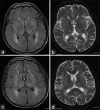Leukoencephalopathy in Mitochondrial Neurogastrointestinal Encephalomyopathy-Like Syndrome with Polymerase-Gamma Mutations
- PMID: 31359948
- PMCID: PMC6613405
- DOI: 10.4103/aian.AIAN_34_18
Leukoencephalopathy in Mitochondrial Neurogastrointestinal Encephalomyopathy-Like Syndrome with Polymerase-Gamma Mutations
Abstract
Mitochondrial neurogastrointestinal encephalomyopathy (MNGIE) syndrome, caused by mutations in the thymidine phosphorylase gene, manifests as a multisystemic disorder characterized by severe gastrointestinal dysmotility, cachexia, ptosis and ophthalmoparesis, peripheral neuropathy, and leukoencephalopathy. These clinical manifestations, with the exception of leukoencephalopathy, are mimicked by MNGIE-like syndrome, linked to polymerase-gamma (POLG) gene. Here, we report a 49-year-old Chinese man with MNGIE-like syndrome involved leukoencephalopathy and was associated with novel POLG mutations. This case expands the clinical spectrum of MNGIE-like syndrome.
Keywords: Leukoencephalopathy; mitochondrial disorders; mitochondrial neurogastrointestinal encephalomyopathy-like; polymerase-gamma gene.
Conflict of interest statement
There are no conflicts of interest.
Figures

References
-
- Hirano M, Nishigaki Y, Martí R. Mitochondrial neurogastrointestinal encephalomyopathy (MNGIE): A disease of two genomes. Neurologist. 2004;10:8–17. - PubMed
-
- Van Goethem G, Schwartz M, Löfgren A, Dermaut B, Van Broeckhoven C, Vissing J, et al. Novel POLG mutations in progressive external ophthalmoplegia mimicking mitochondrial neurogastrointestinal encephalomyopathy. Eur J Hum Genet. 2003;11:547–9. - PubMed
-
- Tang S, Dimberg EL, Milone M, Wong LJ. Mitochondrial neurogastrointestinal encephalomyopathy (MNGIE)-like phenotype: An expanded clinical spectrum of POLG1 mutations. J Neurol. 2012;259:862–8. - PubMed
-
- Prasun P, Koeberl DD. Mitochondrial neurogastrointestinal encephalomyopathy (MNGIE)-like phenotype in a patient with a novel heterozygous POLG mutation. J Neurol. 2014;261:1818–9. - PubMed

